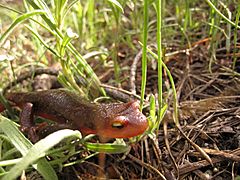Sierra newt facts for kids
Quick facts for kids Sierra newt |
|
|---|---|
 |
|
| Scientific classification | |
| Kingdom: | |
| Phylum: | |
| Class: | |
| Order: | |
| Family: | |
| Genus: | |
| Species: | |
| Subspecies: |
T. t. sierrae
|
| Trinomial name | |
| Taricha torosa sierrae |
|
The Sierra newt is a type of newt that lives in California, in Western North America. Its scientific name is Taricha sierrae. You can find these newts west of the Sierra Nevada mountains, from Shasta County down to Tulare County.
Adult Sierra newts are usually about 5 to 8 inches (13 to 20 cm) long. Their skin makes a strong poison.
Contents
Is the Sierra Newt a Separate Species?
For a long time, people thought the Sierra newt was just a type of California newt. Its old scientific name was Taricha torosa sierrae. But in 2007, scientists decided that the Sierra newt and the California newt are actually two different species. They are now seen as "distinct evolutionary lineages," meaning they have developed separately over time.
Where Do Sierra Newts Live?
Sierra newts mostly live in the Sierra Nevada mountains. They like places that are not too wet, which is different from some other newts. When it's not breeding season, these newts live on land. They often hide in rock cracks or under logs.
Sierra Newt Life Cycle
How Sierra Newts Reproduce
Sierra newts usually reproduce between December and early May. The adult newts often go back to the same water pool where they were born.
First, the male and female newts do a special mating dance. Then, the male climbs onto the female's back and rubs his chin on her nose. He then places a small packet of sperm, called a spermatophore, on the ground or a rock. The female then picks up this packet with her body.
The female lays between 7 and 30 eggs in a group. This egg mass feels like thick jelly. She usually attaches the eggs to plant roots in streams or to rocky spots in small, slow-moving pools of water. Sometimes, they attach eggs to underwater rocks or fallen leaves. These pools are usually about 3 to 7 feet (1 to 2 meters) deep.
Adult newts stay in these pools during the breeding season. You might even see them there into the summer. The baby newts, called larvae, hatch in early to mid-summer. The exact time depends on how warm the water is. Larvae are hard to spot in streams because they blend in well with the sandy bottom. They usually stay close to the bottom.
Sierra Newt's Poison and Predators
Like other newts in the Taricha family, Sierra newts have special glands in their skin. These glands release a very strong poison called tetrodotoxin. This poison is hundreds of times stronger than cyanide. It's the same kind of poison found in pufferfish and some frogs.
Scientists think that tiny bacteria make this tetrodotoxin. The newts get the poison by eating these bacteria. This poison is strong enough to kill most animals with backbones, including humans. However, it is only dangerous if someone eats it.
Because they are so poisonous, Sierra newts do not have many natural enemies. Garter snakes are their most common predators. Some types of garter snakes have even developed a special resistance to the newt's poison.
This has led to an "evolutionary arms race" between the newts and the snakes. Snakes that can handle more poison survive better. This means newts that make more poison are also more likely to survive. This back-and-forth has caused newts to produce much more poison than they would need for any other animal.
What Sierra Newts Eat
Sierra newts eat many different small creatures. Their diet includes earthworms, snails, slugs, woodlice, bloodworms, mosquito larvae, crickets, and other small invertebrates. They also eat trout eggs.
If a Sierra newt is kept in an aquarium, earthworms can give it all the nutrients it needs. Other natural foods would also be good for a newt living in captivity. It's usually not good to feed them pellets or fish food.
Images for kids
See also
 In Spanish: Tritón de Sierra para niños
In Spanish: Tritón de Sierra para niños


